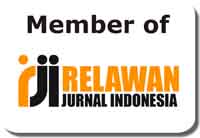Willingness to Communicate in English: An Interview Study with Indonesian Vocational High School Students
Abstract
Research into willingness to communicate in English has gained momentum in second/foreign language learning recently. Applied linguists have argued for the factors that may hinder learners to communicate in English. However, although extensive studies on willingness to communicate in English have been carried out, the studies have much focused on university and high school students. As a result, very little is known about the hindrances of students' willingness to communicate in English in the context of vocational high schools. To fill such a lacuna, this study was designed to explore hindrances of willingness to communicate in English among Indonesian vocational high school students. In-depth interviews were conducted with 6 participants from three Indonesian vocational high schools with regard to the hindrances they encountered when communicating in English. To analyze the data, we employed Braun and Clarke’s (2006) thematic analysis. Findings from the study suggest four emerging themes: 1) lack of self-confidence, 2) presence of fear, 3) teacher's teaching style, 4) and vocabulary provision. Our study reveals that, even though the participants are aware of the problems, situated supports in the forms of out-of-class English communications are needed to help solve their hindrances in English communications. Pedagogical implications of this study are offered at the end of this article.
Keywords
Full Text:
PDFReferences
Alimorad, Z., & Farahmand, M. (2021). A case study on willingness to communicate in English in the Iranian tertiary educational context. TEFLIN Journal, 32(1), 1-28. http://dx.doi.org/10.15639/teflinjournal.v32i1/1-28
Basöz, T., & Erten, I. H. (2019). A Qualitative inquiry into the factors influencing EFL learners' in-class willingness to communicate in English. Novitas-ROYAL (Research on Youth and Language), 13(1), 1-18. http://www.novitasroyal.org/
Braun, V., & Clarke, V. (2006). Using thematic analysis in psychology. Qualitative research in psychology, 3(2), 77-101. https://doi.org/10.1191/1478088706qp063oa
Creswell, J. W., Shope, R., Plano Clark, V. L., & Green, D. O. (2006). How interpretive qualitative research extends mixed methods research. Research in the Schools, 13(1), 1-11.
Darasawang, P., & Reinders, H. (2021). Willingness to communicate and second language proficiency: A correlational study. Education Sciences, 11(9), 517. https://doi.org/10.3390/educsci11090517
Dewaele, J. M., Saito, K., & Halimi, F. (2022). How teacher behaviour shapes foreign language learners’ enjoyment, anxiety and attitudes/motivation: A mixed modelling longitudinal investigation. Language Teaching Research, 13621688221089601.
Evnitskaya, N., & Berger, E. (2017). Learners’ multimodal displays of willingness to participate in classroom interaction in the L2 and CLIL contexts. Classroom Discourse, 8(1), 71-94. https://doi.org/10.1080/19463014.2016.1272062
Fajri, R., & Alimin, R. (2021). The relationship between students` communication willing to speaking English skills. Journal of Education and Science, 7(2), 138-141. https://doi.org/10.3314/jes.v7i2.1780
Henry, A., Thorsen, C., & MacIntyre, P. D. (2021): Willingness to communicate in a multilingual context: part two, person-context dynamics, Journal of Multilingual and Multicultural Development, doi: 10.1080/01434632.2021.1935975
Kasper, G. (2004). Participant orientations in German conversation‐for‐learning. The Modern Language Journal, 88(4), 551-567. https://doi.org/10.1111/j.0026-7902.2004.t01-18-.x
Kemendikbud. (2023). Karya anak bangsa siswa sekolah menengah kejuruan [The nation’s children work of vocational high school students]. Accessed from https://www.vokasi.kemdikbud.go.id/Karya-Anak-Bangsa/Sekolah-Menengah-Kejuruan, June 11, 2023.ee, S.,
Maleki, A., & Zangani, E. (2007). A survey on the relationship between English language proficiency and the academic achievement of Iranian EFL students. Asian EFL Journal, 9(1), 86-96. http://www.asian-efl-journal.com/
MacIntyre, P. D. (2007). Willingness to communicate in the second language: Understanding the decision to speak as a volitional process. The modern language journal, 91(4), 564-576. https://doi.org/10.1111/j.1540-4781.2007.00623.x
MacIntyre, P. D., Clément, R., Dörnyei, Z., & Noels, K. A. (1998). Conceptualizing willingness to communicate in a L2: A situational model of L2 confidence and affiliation. The Modern Language Journal, 82(4), 545-562. https://doi.org/10.1111/j.1540-4781.1998.tb05543.x
Murtadha, I. A. M. A. (2018). The influence of gender, time budget and auditor experience on audit judgment (Empirical Study of Public Accounting Firms (KAP) and the Supreme Audit Agency (BPK) in West Sumatra). Jurnal Akuntansi, 6(1). https://ejournal.unp.ac.id/students/index.php/akt/article/view/2786/0
Setyan, R. N., Widianingsih, S., Nisa, K., Rahmawati, N., & Subekti, N. (2020). Development of innovative teaching materials based on English for specific purposes (ESP) to improve communicative competency skills of class XI multimedia students. Buletin Literasi Budaya Sekolah, 2(1). https://doi.org/10.23917/blbs.v2i1.11612
Salam, N., Ubaidillah, M. F., & Putri, A. N. (2021). Indonesian ESP students’ willingness to communicate in English: Focusing on situated factors. Journal of Asia TEFL, 18(1), 336-344. https://doi.org/10.18823/asiatefl.2021.18.1.25.336
Tavakoli, P. (2023). Making fluency research accessible to second language teachers: The impact of a training intervention. Language Teaching Research, 27(2), 368-393. https://doi.org/10.1177/1362168820951213
Ubaidillah, M. F. (2018). Uncovering EFL teachers’ beliefs of English as an international language. Korea TESOL Journal, 14(2), 139-152.
Wijaya, I. K. (2015). Learning English in elementary schools. BAHTERA: Jurnal Pendidikan Bahasa dan Sastra, 14(2), 120-128. https://doi.org/10.21009/BAHTERA.142.02
Yashima, T., MacIntyre, P. D., & Ikeda, M. (2018). Situated willingness to communicate in an L2: Interplay of individual characteristics and context. Language Teaching Research, 22(1), 115-137. https://doi.org/10.1177/1362168816657851
DOI: http://dx.doi.org/10.31332/lkw.v0i0.5921
Copyright (c) 2023 Muhammad Yunus, Erfan Efendi, Erfan Efendi, Ronald Ronald, Ronald Ronald, M. Faruq Ubaidillah, M. Faruq Ubaidillah, Huan Yik Lee, Huan Yik Lee

This work is licensed under a Creative Commons Attribution-ShareAlike 4.0 International License.
Langkawi: Journal of The Association for Arabic and English indexed by:


















.png)
.png)

.png)
2.png)








